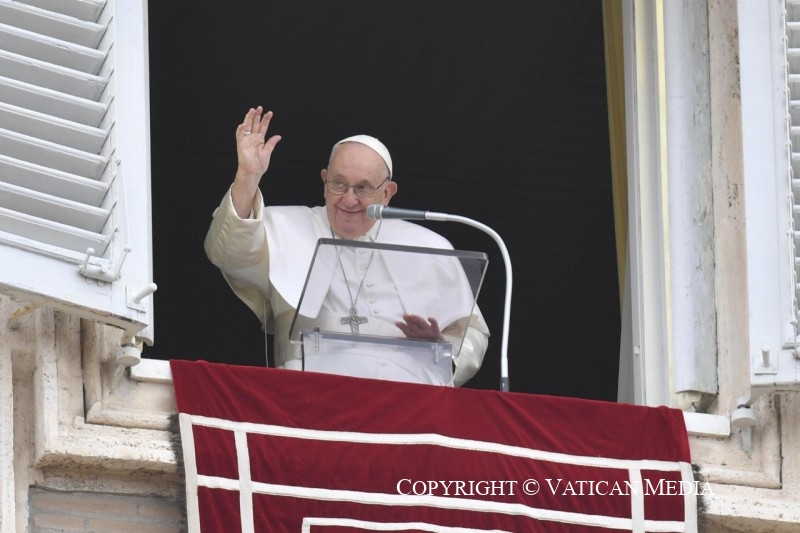Dear brothers and sisters, buongiorno!
Today, fifth Sunday of Lent, the Gospel presents to us the resurrection of Lazarus (cf. Jn 11:1-45). It is the last of Jesus’ miracles narrated before Easter: the resurrection of his friend Lazarus. Lazarus is a dear friend of Jesus, who knows he is about to die; he sets out on his journey, but arrives at his house four days after the burial, when by now all hope is lost. His presence, however, rekindles a little confidence in the hearts of the sisters Martha and Mary (cf. vv. 22, 27). They cling to this light, to this small hope, despite their suffering. Jesus invites them to have faith, and asks for the tomb to be opened. He then prays to the Father and shouts to Lazarus: “Come out!” (v. 43). And the latter comes back to life and comes out. This is the miracle, just like that, simple.
The message is clear: Jesus gives life even when it seems that all hope has gone. It happens, at times, to feel hopeless – this has happened to us all – or to meet people who have given up hope: embittered by bad experiences, the wounded heart cannot hope. Because of a painful loss, an illness, a bitter disappointment, a wrong or a betrayal suffered, a grave error committed… they have given up hope. At times we hear those who say that “There is nothing more to be done!”, and close the door to every hope. They are moments when life seems to be a sealed tomb: everything is dark, and around us we see only sorrow and despair. Today’s miracle tells us that it is not like that, this is not the end, that in these moments we are not alone; on the contrary, it is precisely in these moments that He comes closer than ever to restore life to us. Jesus weeps: the Gospel tells us that Jesus wept in front of Lazarus’ tomb, and today Jesus weeps with us, as he was able to weep for Lazarus: the Gospel repeats twice that he is moved (cf. vv. 33, 38), emphasizes that he burst into tears (cf. v. 35). And at the same time Jesus invite us not to stop believing and hoping, not to let ourselves be crushed by negative feelings, which take away our tears. He approaches our tombs and says to us, as then: “Take away the stone” (v. 39). In these moments, it is as though we have a stone inside, and the only one capable of removing it is Jesus, with his word: “Take away the stone”.
Jesus says this to us too. Take away the stone: the pain, the mistakes, even the failures, do not hide them inside you, in a dark, lonely, closed room. Take away the stone: draw out everything that is inside. “Ah, but I am ashamed”. Throw it to me with confidence, says the Lord, I will not be outraged; throw it to me without fear, because I am with you, I care about you and I want you to start living again. And, as he did with Lazarus, he repeats to each one of us: Come out! Rise again, get back on the path, regain your confidence! How many times, in life, we find ourselves like this, in this situation of no longer having the strength to get up again. And Jesus: “Go, go on! I am with you”. I will take you by the hand, says Jesus, like when you were a child learning to take your first steps. Dear brother, dear sister, take off the bandages that bind you (cf. v. 45); please, do not give in to the pessimism that depresses you, do not give in to the fear that isolates, do not give in to the discouragement caused by the memory of bad experiences, do not give in to the fear that paralyses. Jesus tells us, “I want you free and alive, I will not abandon you and I am with you! Everything is dark, but I am with you! Do not let yourself be imprisoned by pain, do not let hope die. Brother, sister, come back to life!”. “And how can I do this?”. “Take my hand”, and he takes us by the hand. Let you be pulled out: and he is capable of doing it. In these bad moments that happen to us all.
Dear brothers and sisters, this passage, in chapter 11 of the Gospel of John and which it does a great deal of good to read, is a hymn to life, and it is proclaimed when Easter is near. Perhaps we too in this moment carry in our heart some burden or some suffering, that seems to crush us; something bad, some old sin we cannot bring out, some youthful mistake, you never know. These bad things need to come out. And Jesus says, “Come out!”. So, it is the moment to take away the stone and to go out towards Jesus, who is close. Can we open our hearts to him and entrust our worries to him? Shall we do it? Are we able to open the tomb of problems, are we capable, and look over the threshold, towards his light, or are we afraid of this? And in turn, as small mirrors of God’s love, do we manage to illuminate the environments in which we live with words and gestures of life? Do we bear witness to the hope and joy of Jesus? We, sinners, all of us? And also, I would like to say a word to confessors: dear brothers, do not forget that you too are sinners, and you are in the confessional not to torture, but to forgive, and to forgive everything, just as the Lord forgives everything. May Mary, Mother of Hope, renew in us the joy of not feeling alone and the call to bring light into the darkness that surrounds us.
Source: vatican.va





